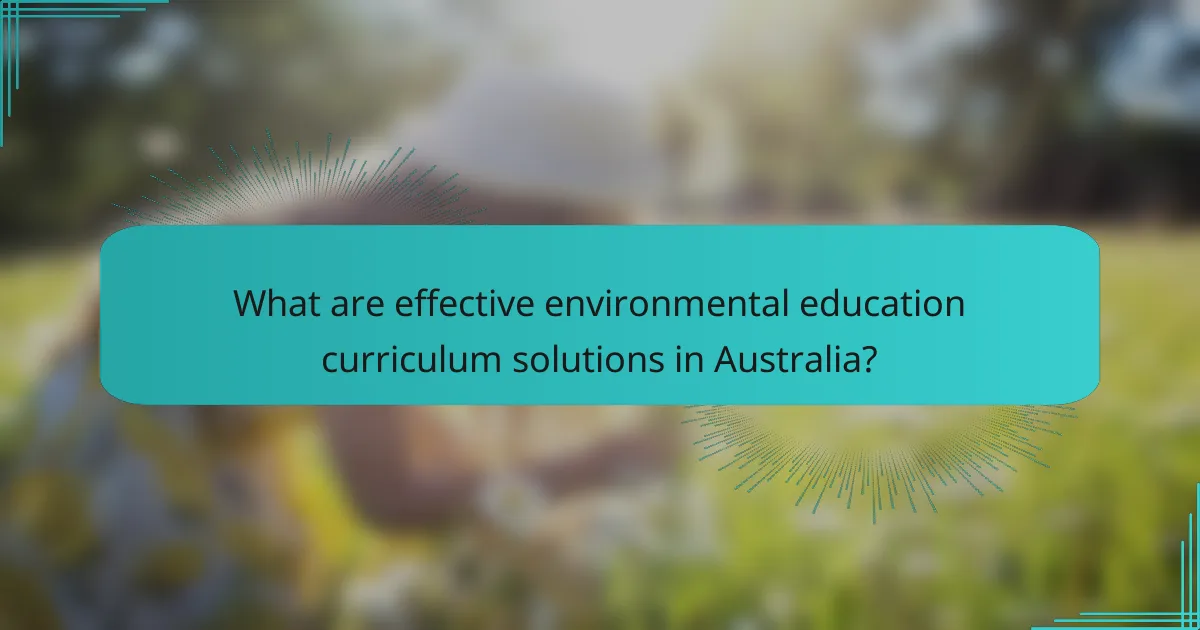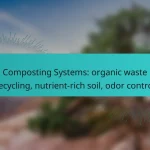Developing an effective environmental education curriculum requires a thoughtful approach to lesson planning, resource selection, and evaluation methods. By focusing on hands-on learning experiences and community engagement, educators can foster a deeper understanding of ecological issues among students. Incorporating diverse resources and structured assessments ensures that learners are not only informed but also actively engaged in addressing environmental challenges.

What are effective environmental education curriculum solutions in Australia?
Effective environmental education curriculum solutions in Australia focus on hands-on learning experiences that connect students with their local environment. These solutions often incorporate project-based learning, community engagement, and technology to foster a deeper understanding of ecological issues.
Project-based learning
Project-based learning (PBL) engages students in real-world environmental challenges, allowing them to explore solutions collaboratively. For example, students might work on a project to reduce waste in their school by implementing recycling programs or creating compost systems.
When planning PBL activities, ensure that projects align with the Australian Curriculum and address local environmental issues. This relevance enhances student motivation and learning outcomes.
Outdoor experiential learning
Outdoor experiential learning immerses students in nature, promoting hands-on experiences that deepen their understanding of ecological concepts. Activities like field trips to local parks or nature reserves allow students to observe ecosystems and biodiversity firsthand.
Incorporating outdoor learning can be as simple as organizing regular nature walks or conducting science experiments outdoors. Ensure that safety protocols are in place and that students are prepared for varying weather conditions.
Interdisciplinary approaches
Interdisciplinary approaches integrate environmental education across various subjects, such as science, geography, and art. This method helps students see the interconnectedness of environmental issues and encourages critical thinking.
For instance, a lesson on climate change might combine scientific data analysis with artistic projects that raise awareness about the issue. Collaborating with other teachers can enhance the effectiveness of this approach.
Community engagement projects
Community engagement projects connect students with local organizations and stakeholders, fostering a sense of responsibility towards their environment. Students can participate in activities like tree planting, clean-up drives, or conservation efforts in collaboration with local councils.
These projects not only benefit the community but also provide students with practical skills and knowledge about environmental stewardship. Establish partnerships with local NGOs to facilitate these initiatives.
Technology integration
Technology integration in environmental education can enhance learning through interactive tools and resources. Utilizing apps for monitoring local wildlife or software for analyzing environmental data can make lessons more engaging.
Consider using virtual reality experiences to simulate ecosystems or environmental challenges, allowing students to explore scenarios they might not encounter in their immediate surroundings. Ensure that technology use aligns with curriculum goals and enhances, rather than distracts from, learning objectives.

How to plan lessons for environmental education?
Planning lessons for environmental education involves setting clear objectives, selecting suitable resources, incorporating assessment methods, and designing engaging activities. This structured approach ensures that learners gain a comprehensive understanding of environmental issues and solutions.
Define learning objectives
Learning objectives should clearly articulate what students are expected to know or do by the end of the lesson. These objectives can range from understanding basic ecological concepts to applying sustainable practices in their daily lives. For example, an objective might be for students to identify local environmental issues and propose actionable solutions.
When defining objectives, consider using the SMART criteria: Specific, Measurable, Achievable, Relevant, and Time-bound. This ensures that the objectives are clear and attainable within the lesson timeframe.
Select appropriate resources
Choosing the right resources is crucial for effective environmental education. Resources can include textbooks, online articles, documentaries, and interactive tools like simulations or apps. Aim for materials that are age-appropriate and culturally relevant to the students’ backgrounds.
Incorporate a mix of resources to cater to different learning styles. For instance, visual learners may benefit from videos, while kinesthetic learners might engage more with hands-on activities. Always evaluate the credibility of the resources to ensure accurate information is presented.
Incorporate assessment methods
Assessment methods should align with the learning objectives and provide insights into student understanding. Consider using formative assessments, such as quizzes or group discussions, to gauge comprehension during the lesson. Summative assessments, like projects or presentations, can evaluate overall learning at the end.
Utilize rubrics to provide clear criteria for performance and feedback. This not only helps students understand expectations but also allows for consistent grading. Regular reflection on assessment outcomes can inform future lesson adjustments.
Design engaging activities
Engaging activities are essential for maintaining student interest and promoting active learning. Incorporate hands-on projects, field trips, or community service initiatives that connect students with real-world environmental issues. For example, organizing a local clean-up event can foster teamwork and a sense of responsibility.
Utilize collaborative learning techniques, such as group discussions or peer teaching, to encourage interaction among students. Incorporating technology, like virtual reality experiences related to environmental topics, can also enhance engagement and understanding.

What resources are essential for environmental education?
Essential resources for environmental education include guidelines from government bodies, support from local organizations, digital tools, and various books and multimedia materials. These resources help educators create effective lesson plans and enhance student engagement with environmental topics.
Government guidelines and frameworks
Government guidelines and frameworks provide a structured approach to environmental education, ensuring alignment with national standards. In many countries, these frameworks outline key competencies and learning outcomes that students should achieve.
Educators should familiarize themselves with local regulations and policies that promote sustainability and environmental literacy. For example, the U.S. Environmental Protection Agency (EPA) offers resources that can be integrated into lesson plans, ensuring compliance with educational standards.
Local environmental organizations
Local environmental organizations are invaluable partners in environmental education, offering expertise, resources, and community engagement opportunities. These organizations often provide workshops, field trips, and guest speakers to enhance learning experiences.
Collaborating with local groups can help educators access hands-on activities and real-world applications of environmental concepts. For instance, a partnership with a local conservation group can facilitate student projects focused on habitat restoration or pollution reduction.
Digital tools and platforms
Digital tools and platforms play a crucial role in modern environmental education, providing interactive and engaging resources. Websites, apps, and online courses can supplement traditional teaching methods, making complex topics more accessible.
Educators should consider using platforms like Google Earth for virtual field trips or educational apps that promote sustainability practices. Additionally, online forums and social media can connect students with global environmental movements, fostering a sense of community and shared responsibility.
Books and multimedia resources
Books and multimedia resources are essential for providing foundational knowledge and diverse perspectives on environmental issues. A well-rounded library should include textbooks, documentaries, and interactive materials that cater to various learning styles.
When selecting resources, prioritize those that are current and relevant to local environmental challenges. For example, books that focus on regional ecosystems or case studies can help students relate their learning to their immediate surroundings and inspire action.

How to evaluate environmental education programs?
Evaluating environmental education programs involves assessing their effectiveness in achieving learning objectives and fostering environmental awareness. This process typically includes both formative and summative evaluation methods to ensure comprehensive feedback and improvement.
Formative assessment techniques
Formative assessment techniques are ongoing evaluations that provide real-time feedback during the educational process. These methods can include quizzes, peer reviews, and reflective journals, allowing educators to gauge student understanding and adjust instruction accordingly.
For instance, using short quizzes after each lesson can help identify areas where students struggle, enabling timely interventions. Additionally, incorporating student feedback through discussions can enhance engagement and tailor the curriculum to better meet learners’ needs.
Summative evaluation methods
Summative evaluation methods assess the overall effectiveness of an environmental education program at its conclusion. Common techniques include final exams, project presentations, and standardized assessments that measure knowledge retention and application.
For example, a capstone project where students design a community awareness campaign can serve as a summative assessment, showcasing their understanding and ability to apply concepts learned throughout the course. It’s essential to align these evaluations with specific learning outcomes to ensure they accurately reflect student achievement.


